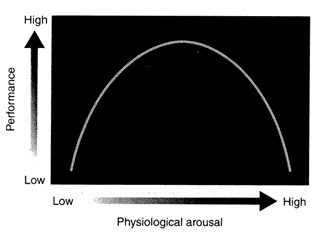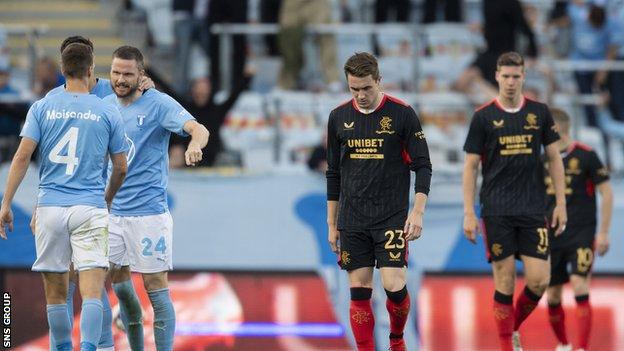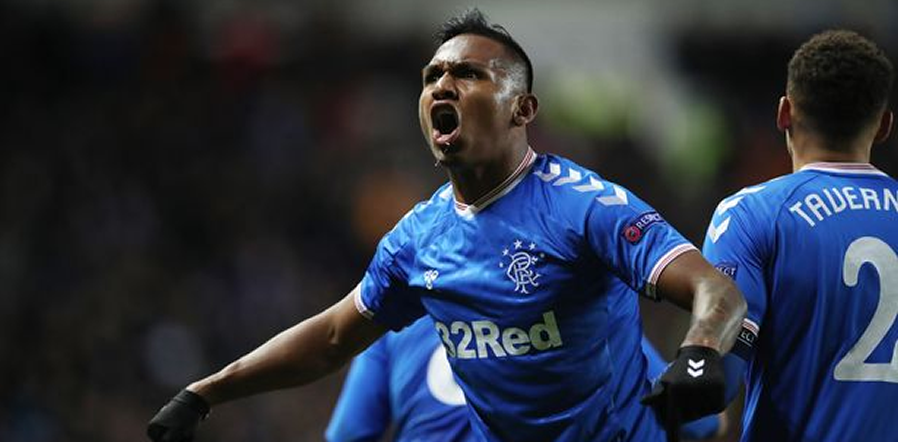Well, this hasn’t been fun has it? Invincible domestically no longer and the bright lights of the Champions League snuffed out before we even had the chance to see them, the past week has seen the support and the club come crashing down to earth from the cloud 9 we were on during the summer after last seasons title defence. One defeat at Rangers is bad, two in four days is unthinkable and three in seven is just catastrophic. There is no hiding from the fact that if the players, the management or anyone at the club thought they could dine out on the success of 55 forever they are sorely mistaken – the supporters have stuck by the club in much tougher times than these but at no point will they accept what we have seen on and off the park over the past week.
If there has been one positive from an otherwise negative start to our campaign, it is that stadiums are now beginning to host capacity crowds again, and the atmosphere at Ibrox on Tuesday evening was superb. The team could not have asked for better backing in one of the biggest games our club has played in a decade. However, the return of crowds coupled with the downturn in form has led to some accusations that this Rangers team simply cannot handle the heat; when the pressure Is on, these players experience stage fright.
It is an accusation against Steven Gerrard’s Rangers that is now starting to seep its way into the mainstream Scottish football psyche (including some within the Rangers support who worry that crowds may have an adverse effect on the side). For that reason, I would like to take this opportunity to look at the psychology behind the accusation, how it relates to Rangers and analyse the accuracy of the claim from that standpoint.
Defining Stage Fright
Stage fright (or “performance anxiety” to give it its proper title) is several anxieties that affect the performance of individuals during public speaking, musical, dancing and sporting events. It is a diagnosable medical condition, with performance anxiety being the number one medical condition diagnosed to professional musicians in orchestras. It has been reported to not just harm performance, but also the physical and mental health of those afflicted as it does not just occur at the time of the performance but can occur as far away as months before the event begins. In short, the most recent definition of performance anxiety from leading psychologists is:
“an experience of marked and persistent anxious apprehension related to performance… which is manifested through combinations of affective, cognitive, somatic and behavioural symptoms”.
So, stage fright is obviously a very serious and often debilitating condition for professionals whose jobs require them to perform in front of crowds – such as footballers – but what are those anxieties that drive performance anxiety?
Cognitive/Somatic Anxiety
Cognitive and Somatic anxieties are something I have mentioned a lot about both how the team sees themselves and how we see the team – as both are important factors, especially with regards to the topic of playing in front of crowds. Cognitive anxiety is the psychological component of anxiety while somatic anxiety is the physical. For example, cognitive anxiety is caused by negative expectations about your chances of succeeding or persistent negative self-reflection which results in continual worries that detriment performance levels. This can be caused by negative previous experiences that lead to cognitive anxiety as the human brain has been described by neuroscientist Rick Hanson as being like “Velcro for negative experiences and Teflon for positive ones”. On the other hand, somatic anxiety is the physical reaction to experiences of anxiety such as cardiovascular issues (increased heart rate and high blood pressure) as well as shortness of breath, clammy hands, insomnia and fatigue.
It Is important here to mention two key points. Firstly, anxiety is a separate entity from fear – they are not the same thing. Freud wrote that while anxiety produces similar sensations both psychologically and physically as fear, anxiety is a more complex experience as fear can be more easily reduced than anxiety. Secondly and while this may seem counterintuitive to everything that has been said so far; anxiety (specifically cognitive anxiety) is not always a bad thing for performance and in fact has been known to drive high levels of performance (more on this later).
The Crowd Factor
There have been several studies as to the effect an audience can have on a sportsperson’s performance. Crowds have been said to create psychological arousal (the intensity of the feeling of motivation in a particular moment), with theorists suggesting that this drives up the performance levels of well-learned tasks. In a Rangers context, these well-learned tasks can be elements of the game such as in-game tactics and set-piece routines as well as the fundamental mechanics needed to play football. This would support the well-known fact in football that fans can often make a difference in games, as the atmosphere they create has the potential to overwhelm opposition players. On the other hand, there have been suggestions that the same crowd’s passion can often have the adverse effect and overwhelm their own players, with a study of the NBA finding that “home advantage” often turned into a disadvantage in the championship playoffs as the pressure mounted on the home side to deliver a high level of performance which they subsequently failed to do.
This is often called “choking” or “bottling” when the pressure is on, particularly in front of an audience or crowd. Some theorists say that this occurs when the athlete attempts to process an increased amount of information that inhibits their well-learned tasks or when cognitive anxiety takes over leading to somatic anxiety which again inhibits their ability to perform at their optimum level.
This, as I see it, is the crux of the accusation labelled against this Rangers side – that when the crowd is there and the pressure is on, they crumble due to their inability to manage their cognitive anxieties. However, I think these same factors can be used to not only dispel this claim but actually be used to prove that Steven Gerrard’s Rangers can and have performed at their very best in front of crowds with some examples of games good and bad.
The Rangers Context
As has been previously stated, the link between cognitive anxiety and performance is an inherently complex phenomenon, yet as can be seen below in figure 1.0 (a and b) it has a fairly simple effect on performance.

Here, we see the effects of high and low cognitive anxiety on performance levels. When the athlete is under little anxiety and stress, there is very little to drive performance to the optimum level. However, as you can see from figure b, an optimum amount of stress and anxiety can actually drive performance to its peak. The problem arises when that balance between anxiety and performance fails, and both collapse. This is known as The Catastrophe Model. This on the surface may seem like an argument against the squad’s mentality, saying that once the pressure from the crowds is ramped up, they cannot perform and fall off a cliff – the “catastrophe point” – however as we will come on to shortly, I believe that this actually proves the opposite.
This psychological model is supported by the “Inverted U-hypothesis” which suggests that much like cognitive anxiety, when psychological arousal peaks to a certain point, the performance of the athlete does also (this can be seen in Figure 2.0) however when that arousal becomes too much, the performance suffers a rapid decline resulting in the “catastrophe”.

However, a look at previous Rangers fixtures with capacity crowds shows this is not the case as there is no direct pattern of this happening.
I take you back to the 29th of December 2018 where Rangers secured our first Old Firm win in thirteen games. Ibrox that day was raucous, and the support was tremendous, but as the minutes ticked on and the win was within touching distance, the pressure to hold out became immense. We all knew what a win would do to improve our confidence and what a late equaliser would have done to strengthen Celtics psychological grip over us at the time. At that moment, when psychological arousal and cognitive anxiety were at their peak from the fans, this Rangers sides performance peaked with it. This is an example of Rangers hitting their “Individualised Zones of Optimal Functioning” (IZOF), where the heightened state of anxiety drove their performance to optimum levels (Figure 3.0). These IZOF’s were hit in front of a capacity Ibrox, with the expectation rising and rising and the pressure mounting.

To demonstrate this was not a one-off, fast forward exactly one year later. Rangers travelled to a packed Parkhead just weeks after the disappointment of the League Cup Final with a slither of travelling fans and won 2-1. This was a completely different kind of crowd pressure to the one at Ibrox in front of a supportive crowd, and if anything deserves more credit as a result of that. Playing in a deeply hostile environment, with 60,000 fans baying for their blood, this Rangers team once again hit their IZOF’s while in a state of high cognitive anxiety and psychological arousal. This showed that Rangers could do it when they are up against an antagonistic crowd when the pressure was thrust upon them from the stands, demonstrating that they can indeed do the business in that environment.
Even (and I am sorry for bringing this up) that aforementioned League Cup Final I believe demonstrates our ability to perform when the pressure from crowds is on despite the fact the result didn’t go our way. For many of the players within the squad, that was their first taste of a final in a competition with Rangers and, as hard a pill as it is to swallow, they put in a performance deserving to win the game and had it not been for a Man of the Match display from Fraser Forster and poor officiating, that would have been the case. Using this game as a case study and measuring it against the catastrophe model, it is clear to see that the players rose to the challenge in the highest-pressure fixture many of them had played in and had it not been for lady luck turning her back on them they would have been granted their just reward.
This is of course just to name but a few fantastic results that Rangers have achieved with capacity crowds. For European examples, Legia Warsaw springs to mind. The longer that game went on, the higher the risk factor became that an away goal could kill the tie. The pressure on the players to get through that night was palpable, even from a supportive crowd that stayed with the team. Here, once again, when the players would have been under the most pressure, they delivered.
So what has happened over the last 10 days? These players haven’t just stopped hitting their IZOF’s all of a sudden because they are scared of crowds, nor have they reached the psychological state of catastrophe as defined in the model. For us as fans, we can only speculate that It is a culmination of a disrupted pre-season, players returning at various stages from international duty and some possible other behind the scenes factors that only the players and club know about.
However, there is one certainty – the accusation that crowds are behind the defeat to Dundee United and the exit from the Champions League Qualifiers just does not stand up to any academic scrutiny. Using what we know from psychological studies conducted by academic theorists on the Catastrophe Model, Cognitive Anxiety, Psychological Arousal and Individualised Zones of Optimal Functioning, this Rangers side has passed the tests. This narrative has been set first and foremost not by our own fans expressing genuine concern, but by those who would be quite happy to see this become a self-fulfilling prophecy. I find it personally to be a claim that is as cheap as it is lazy – a black and white answer to a question that is multiple shades of grey and the evidence does support this conclusion.
Finally, my usual thank you for reading. I know the start to this season has been far from what we had dreamt of, but let’s try and reclaim the narrative that is surrounding our players off the park as they try to reclaim their form on it. If this article has gone even some way to do that then it has been a success.
Twitter: @HeartandHutts




